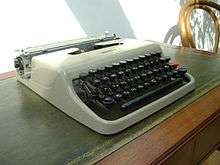Olivetti Lettera 22

The Olivetti Lettera 22 [oliˈvetti ˈlɛttera ventiˈdue] is a portable mechanical typewriter designed by Marcello Nizzoli in 1949 or, according to the company's current owner Telecom Italia, 1950.[1] This typewriter was very popular in Italy, and it still has many fans. It was awarded the Compasso d'oro prize in 1954. In 1959 the Illinois Institute of Technology chose the Lettera 22 as the best design product of the last 100 years.
The typewriter is sized about 27x37x8 cm (with the carriage return lever adding about 1–2 more centimeters in height), making it quite portable at least for the time's standards, even though its 3.7 kg (8.2 lb) weight may limit portability somewhat.



The model was eventually succeeded by the Olivetti Lettera 32.
Mechanics
The Lettera 22 is an oblique frontstroke typebar typewriter. The typebars strike a red/black inked ribbon, which is positioned between the typebar and the paper by a lever whenever a key is pressed; a small switch located near the upper right side of the keyboard can be used to control the strike position of the ribbon, in order to print with black, red, or no ink (for mimeograph stencils).
Ribbon movement, which also occurs at every keypress, automatically reverses direction when there is no ribbon left on the feed reel; two mechanical sensors, situated next to each wheel, move when the ribbon is put under tension (indicating ribbon end), attaching the appropriate wheel to the ribbon transport mechanism and detaching the other.
The Lettera 22 uses a basket shift or segment shift (that is, the unit including the typebars moves up and down when shifting, as opposed to the carriage shift system). The Lettera 22 is quite compact compared to other 1950s portable typewriters using a basket shift, such as the Smith Corona Sterling or Remington-Rand Quiet-Riter.
The Lettera 22 also features a tabulator setting and clearing system that is controlled from the keyboard, and an innovative margin release that does double duty as a paragraph indentation key (it indents a paragraph when it is held down as the carriage is returned).
Keyboard
For the Italian market the keyboard is in the QZERTY layout, as with most Italian machines (excluding modern computer keyboards). Aside from the typing keys, the keyboard includes a space bar, two shift keys, one caps lock key, a backspace key and a margin release key. Of these, only the backspace key bears a mark on it (an arrow pointing right), while the other five mentioned are left anonymous.
The character set conspicuously lacks the numbers 0 and 1, which are supposed to be substituted by the uppercase "o" and lowercase "l"'. Although this may seem like a strange absence today, this was actually common on older typewriters.[2]
Also lacking are the keys for uppercase accented vowels, some of which are present in Italian; however, these characters usually are not found on modern keyboards, either.
Layout
Normal
| é | " | ' | ( | _ | è | ^ | ç | à | ) | - |
| q | z | e | r | t | y | u | i | o | p | ì |
| a | s | d | f | g | h | j | k | l | m | ù |
| w | x | c | v | b | n | , | ; | : | ò |
Shifted
| 2 | 3 | 4 | 5 | 6 | 7 | 8 | 9 | & | ° | + |
| Q | Z | E | R | T | Y | U | I | O | P | = |
| A | S | D | F | G | H | J | K | L | M | % |
| W | X | C | V | B | N | ? | . | / | ! |
In popular culture
The Olivetti Lettera 22 is mentioned on pg. 15 of Thomas Pynchon's 2009 novel Inherent Vice.
Poet and singer Leonard Cohen[3] and actor Tom Hanks[4] have expressed use and ownership of this typewriter.
Indro Montanelli, the famous Italian journalist and newspaper director, used his Lettera 22 almost everywhere: a monument - inspired from a famous photo of him taken in the 1950s - in a Milan's public gardens Giardini Pubblici Indro Montanelli is dedicated to him and to his Lettera 22.
Günter Grass, the German writer, had three Olivetti Lettera and typed his work exclusively on this machine: In Portugal, in Germany (Schleswig-Holstein, his home), and in his house in Denmark.
See also
Notes
- ↑ Olivetti design at Telecom Italia
- ↑ On a computer keyboard, the numbers are compulsory because computers cannot interpret a letter for a number like humans can.
- ↑ Cohen, Scott (August 1985). "The Portable Leonard Cohen". Spin. p. 25.
- ↑ Warner, Kara (17 July 2012), Tom Hanks' Online Series 'Electric City' A 'Different Brand Of Noir', MTV.com, retrieved 26 November 2012